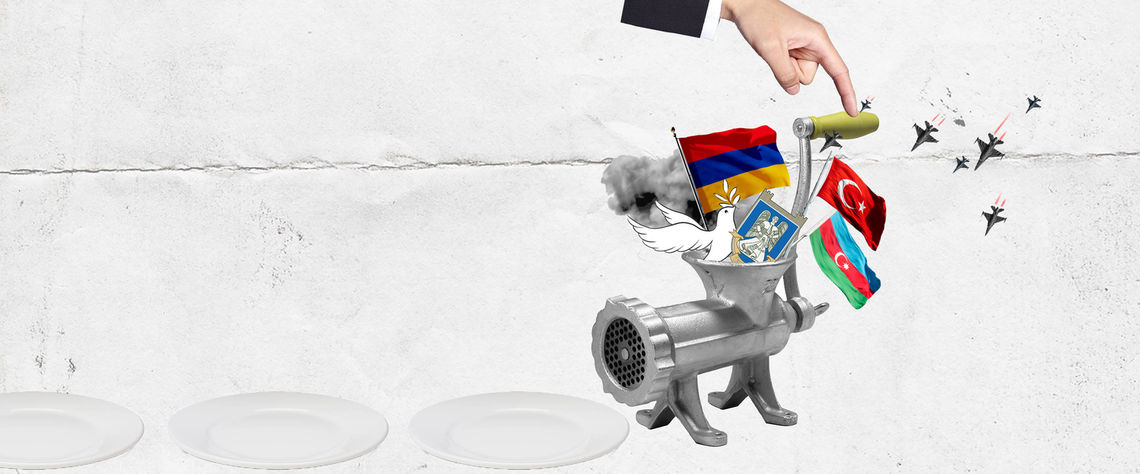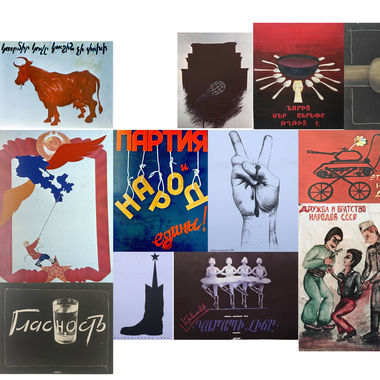
Illustration by Armine Shahbazyan.
On May 20, 2021, a few days after Azerbaijani soldiers had crossed into the Republic of Armenia at Black Lake (Sev Lich), Nikol Pashinyan addressed the National Assembly: “Our most important task is to usher in an era of peaceful development for our people. We must go this way, but we must not have illusions, because, unfortunately, this does not depend only on us: our people should know where we want to take them. I see our work, our role in the opportunity to open an era of peaceful development for Armenia. Today I see that there is an opportunity for that, we just need to show political will, move from the logic of toasts to the logic of tackling the half-solved issues.”
In addition to Syunik region, Azerbaijani soldiers had also advanced into Gegharkunik region. These actions were accompanied with harsh rhetoric by Azerbaijani President Ilham Aliyev, making territorial claims against the Republic of Armenia. At the same time, Azerbaijan started to target Yeraskh, in Ararat region, which borders Nakhichevan. Five months later, despite diplomatic efforts, Azerbaijani soldiers are still on the territory of Armenia. Moreover, the May 2021 provocations resulted in the first human losses[1] for Armenia since the November 9, 2020 ceasefire agreement. According to Armenia’s Ministry of Defense, eight soldiers were killed between May 25 and September 1 because of Azerbaijani advances against Gegharkunik and Yeraskh. The Azerbaijani side has reported one human loss on July 23.[2]
September 27, 2021 marked one year since the start of the 2020 Artsakh War. That day, Ilham Aliyev once again came up with new threats against Armenia, particularly stating “we will crush Armenian fascism again without any hesitation whatsoever. Everyone should know this! The Iron Fist, the symbol of war and victory, is still in place, and let no one forget about that!” This rhetoric, accompanied by the provocative actions, totally contradict the concept of opening “an era of peace”, which the Armenian PM keeps promising, especially after his re-election. Both in Armenia and in Artsakh, people are living under an existential security threat, while a sustainable and long lasting peace seems no more than a wish. The promise to open “an era of peace” is very ambitious but not realistic, especially when we witness how quickly new developments and changes are taking place. It is hard to make precise predictions about this region for the coming five and ten years. Peace cannot be built unilaterally. So, does Armenia have a real peace partner a year after the 2020 Artsakh War? What are the understandings and the descriptions of peace in Armenia, Azerbaijan and Turkey?
Recently, Nikol Pashinyan stated that “Armenia is getting positive signals from Turkey concerning the normalization of relations.” Later, we heard from Turkish President Recep Tayyip Erdogan that Nikol Pashinyan had asked his Georgian counterpart Irakli Garibashvili to assist in establishing direct contacts with Turkey. In his statement, Erdogan “surprisingly” noticed that “from one side, Armenia refuses to talk about opening the ‘corridor’, from the other side, expresses a willingness to meet. If he wants to meet, he needs to act.” Afterwards, on September 27, Turkish Foreign Minister Mevlut Cavusoglu reiterated Turkey’s support to Azerbaijan, particularly highlighting, “Our greatest desire since the beginning is that, after the war is over, the region turns into a place of peace and stability. In this direction, as you know, Azerbaijan has offered to sign a comprehensive peace agreement with Armenia. There has yet to be a positive response from Armenia. But in the next period, as always, we will coordinate the steps we can take together with dear Azerbaijan. We decide together, we take steps together.” Turkey has clearly set preconditions before talks concerning the possible normalization of relations with Armenia. Under the pretext of a “peace treaty”, Azerbaijan and Turkey demand that Armenia:
-
Forget about the right to self-determination of the people of Artsakh
-
Provide a “corridor” through the sovereign territory of Armenia under the control of Azerbaijan and Turkey.
-
Discuss (and potentially surrender) Soviet-era enclaves, which would hobble Armenia’s interstate transportation.
These are only the public aspects of the “treaty”, but it clearly shows that it is not a proposal for building regional peace based on mutual compromises, but mostly a plan to bring about the end of the Armenian state. It is a non-starter for Armenia. Recently, Minister of Foreign Affairs Ararat Mirzoyan stated, “There are currently no negotiations on a peace treaty between Armenia and Azerbaijan. If they start at some point in the future, they should include the issue of the status of Nagorno-Karabakh based on the principles stipulated by the OSCE Minsk Group Co-Chairs.” At the same time, Armenia refused to discuss the possibility of providing a “corridor” to Azerbaijan and Turkey.
Thus, while Azerbaijan and Turkey have not minced words about what the cost of “peace” would be, the Armenian side still highlights the importance of opening regional communications. A precise interpretation and understanding of peace based on state interests and security needs must be provided to avoid any misunderstanding and to mark the red lines in the possible process of achieving regional peace.
Statements made by high-level Azerbaijani and Turkish officials can hardly be interpreted as positive signals. Moreover, they mostly contain threats and are accompanied by joint actions, common policy and, of course, military exercises. Since the November 9, 2020 ceasefire agreement, Azerbaijan and Turkey have carried out about 50 joint military exercises, trainings and consultations, most of them near the border with Armenia, for instance in Kars and Nakhichevan. In September 2021 alone, seven joint military exercises took place, one of them in Berdzor (Lachin), close to the Russian peacekeepers. “During the exercises, special attention was paid to improving the skills of using modern military equipment and other military means in difficult terrain,” the official press release reads. Considering the fact that the Berdzor corridor is essential for Artsakh as the only remaining connection with Armenia, these kinds of drills openly show the intention to cut the connection if and when the regional situation affords. Accordingly, while speaking about peace, our adversarial neighbors are preparing for all possible scenarios to use force for the implementation of their objectives. For comparison, it is worth mentioning that, before the 2020 Artsakh War, large-scale joint military exercises took place in July and August near the border of Armenia.
Apart from joint military exercises, Azerbaijan and Turkey have further enhanced their military cooperation in the post-war period, including new defense cooperation projects on unmanned aerial vehicles (UAVs). They are evaluating joint production of the armed drones in Azerbaijan, according to Turkey’s Defense Industries Chief Ismail Demir. This topic was tackled back in June 2021, when Erdogan and Aliyev visited occupied Shushi. As a result of the joint visit, the Shushi Declaration was signed based on the slogan “one nation, two states”. The declaration openly assumed that “the parties will encourage the exchange of personnel aimed at strengthening the defense capability and military security, conducting joint exercises and trainings, increasing the interaction capabilities of the armed forces of the two countries, cooperating closely in the management of weapons and ammunition on the basis of modern technologies, and ensuring coordinated activities of authorized agencies and institutions for this purpose. Azerbaijan and Turkey will support the implementation of military exercises together with the armies of other friendly states.” A Jamestown Foundation article noted recently that, through systematic joint drills and intensive interactions, the “two states, one nation” mantra has become “two states, one military”.
Apparently, Turkish-Azerbaijani joint activities, in cooperation with Pakistan and Israel, created serious threats not only for the security of Armenia and Artsakh, but other regional actors as well. The obvious policy to solve the regional issues together based on the Turkic ethnic factor became quite problematic and challenging for the entire region. The currently increasing tension between Azerbaijan and Iran is a vivid example of it. Tehran is concerned about Ankara’s fueling Pan-Turkism near its borders, as well as by the engagement of Tel Aviv in the region. Back in December 2020, when Erdogan was participating in the military parade in Baku, he recited a poem containing territorial claims against Iran. Iran was not amused. Another recent round of mutual accusations between Tehran and Baku shows the seriousness of the security threats against Iran. It is noteworthy that Turkey held another joint military exercise with Azerbaijan. “The Steadfast Brotherhood 2021” took place in Nakhichevan on October 5-8 and is considered to be a response to the recent military exercises by Iran’s national army near its border with Azerbaijan.
Interestingly, on October 5, the Defense Ministers of Georgia, Azerbaijan and Turkey met in the Kakheti region of Georgia. The Defense Ministers discussed the current military-political situation, the development of trilateral military cooperation, as well as the issue of ensuring the security of regional projects in the region. In the end, the ministers of the three countries signed a protocol following the results of the talks.
Thus, analyzing the regional developments, rhetoric and undertaken military preparations, unfortunately, one can hardly speak about a realistic peace in the South Caucasus. While delivering a speech at the 76th Session of the UN General Assembly, Nikol Pashinyan mentioned, “So, how are we going to achieve the goal of opening an era of peaceful development for our country and the region? Through dialogue, overcoming incrementally the atmosphere of painful hostility in our region. We realize that the path will be difficult and long. Unfortunately, the incidents designed to delegitimize the peace agenda and deepen and institutionalize the atmosphere of hostility occur on a daily basis. Violations of the ceasefire, aggressive and insulting statements against Armenia and the Armenian people continue to escalate the atmosphere.”
In reality, at this stage, our neighboring states are not interested in peace. Neither our adversaries nor our allies would ever undermine their state interests, strategic plans and national security for the sake of regional peace. The change in the status quo in Nagorno-Karabakh and the military success of Azerbaijan replaced the balance and security system in the whole region, creating new challenges not only for Armenia, but other players of the South Caucasus as well. In the scope of these regional changes, the Armenian Government should be quite careful when promising “an era of peace” to its people. It would be more reasonable to precisely analyze the entire spectrum of developments within and around our country. This will help to properly be prepared for all types of possible scenarios and avoid another similar and undeniably tragic situation we had to face a year ago in Artsakh.
-----------------------
[1] The biggest border clash took place on July 28 in the direction of Gegharkunik, when three Armenian soldiers were killed. Further escalation was prevented due to Russia’s mediation efforts.
[2] The Armenian side rejected the information.
By the same author
Baku Threatens Yerevan With “Peace Treaty”
By Tatevik Hayrapetyan
Developments after the 2020 Artsakh War reveal that Azerbaijan has no intention to work toward regional peace and stability. Together with Turkey, Baku aims to change the regional structure at the expense of Armenia’s security interests and needs.
Also see
A White Paper to Build a Security Architecture
By Tigran Yegavian
What has Armenia’s defeat in the 2020 Artsakh War revealed? Tigran Yegavian reviews a recently published White Paper that looks at a number of misconceptions, failures and dysfunctions within Armenian statehood and attempts to diagnose those ills and offer possible solutions.
Armenia and Azerbaijan Take Fight to ICJ
By Gabriel Armas-Cardona Esq.
Armenia instituted proceedings against Azerbaijan at the International Court of Justice on the basis of violations of the Convention on Elimination of Racial Discrimination. A week later, Azerbaijan submitted its own claim against Armenia. Gabriel Armas-Cardona breaks it down.
What Is France Looking for in the Nagorno-Karabakh Issue?
By Gaïdz Minassian
Since the 2020 Artsakh War, France has been at the forefront of diplomatic activity in resolving the Nagorno-Karabakh conflict. What goal is Paris hoping to achieve with this issue that is so far removed from the concerns of the French?
The Escalating Tensions Between Iran and Azerbaijan
By Hranoush Dermoyan
Since the end of the 2020 Artsakh War, tensions between the Islamic Republic of Iran and Azerbaijan have been escalating. Although an outright military confrontation seems unlikely, it would have devastating consequences for the region.
Breaking the Immunity of Dictators
By Irina Ghaplanyan
Dictators are emboldened by the silence of those who claim to be proponents of human rights and justice. Turkey’s Erdogan and Azerbaijan’s Aliyev must be held accountable for war crimes and crimes against humanity, writes Irina Ghaplanyan.









